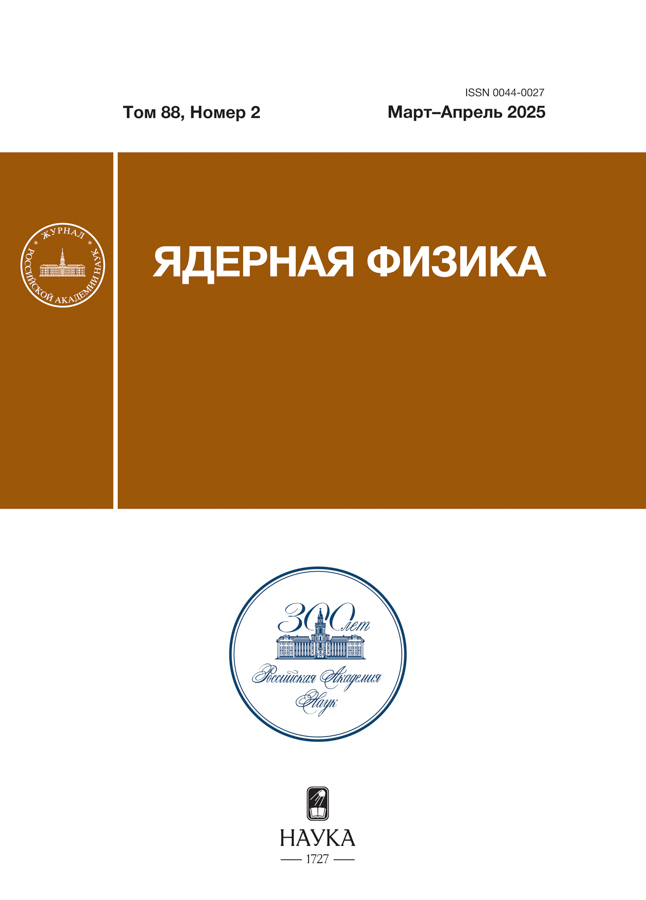Теоретическое исследование процесса радиационного захвата при столкновении ядер дейтерия
- Авторы: Соловьев А.С.1
-
Учреждения:
- Всероссийский научно-исследовательский институт автоматики имени Н.Л. Духова
- Выпуск: Том 87, № 2 (2024)
- Страницы: 108-112
- Раздел: МАТЕРИАЛЫ 73-Й МЕЖДУНАРОДНОЙ КОНФЕРЕНЦИИ ПО ЯДЕРНОЙ ФИЗИКЕ. Ядра. Теория
- Статья опубликована: 07.10.2024
- URL: https://cardiosomatics.ru/0044-0027/article/view/674664
- DOI: https://doi.org/10.31857/S0044002724020076
- EDN: https://elibrary.ru/KRJGYY
- ID: 674664
Цитировать
Полный текст
Аннотация
В настоящей работе исследуется процесс радиационного захвата, протекающий при столкновении дейтронов. Данный процесс представляет значительный интерес для астрофизических приложений. Теоретическую основу исследования составляет микроскопический кластерный подход в осцилляторном представлении. Вычисляются полное и парциальные сечения соответствующей реакции в терминах астрофизического S-фактора. Достигнуто хорошее согласие с экспериментальными данными. Показано, что тензорная сила ядерного взаимодействия играет ключевую роль для описания низкоэнергетической зависимости полного сечения (астрофизического S-фактора).
Полный текст
Об авторах
А. С. Соловьев
Всероссийский научно-исследовательский институт автоматики имени Н.Л. Духова
Автор, ответственный за переписку.
Email: solovyev@mail.ru
Россия, Москва
Список литературы
- R. H. Cyburt, B. D. Fields, K. A. Olive, and T.-H. Yeh, Rev. Mod. Phys. 88, 015004 (2016).
- R. W. Zurmühle, W. E. Stephens, and H. H. Staub, Phys. Rev. 132, 751 (1963).
- F. J. Wilkinson III and F. E. Cecil, Phys. Rev. C 31, 2036 (1985).
- H. R. Weller, P. Colby, J. Langenbrunner, Z. D. Huang, D. R. Tilley, F. D. Santos, A. Arriaga, and A. M. Eiró, Phys. Rev. C 34, 32 (1986).
- C. A. Barnes, K. H. Chang, T. R. Donoghue, C. Rolfs, and J. Kammeraad, Phys. Lett. B 197, 315 (1987).
- J. Zhou, Y.-Y. Fu, S.-H. Zhou, H.-H. Xia, C.-B. Li, and Q.-Y. Meng, Chin. Phys. C 33, 350 (2009).
- Y. Xu, K. Takahashi, S. Goriely, M. Arnould, M. Ohta, and H. Utsunomiya, Nucl. Phys. A 918, 61 (2013).
- F. D. Santos, A. Arriaga, A. M. Eiró, and J. A. Tostevin, Phys. Rev. C 31, 707 (1985).
- J. A. Tostevin, Phys. Rev. C 34, 1497 (1986).
- H. J. Assenbaum and K. Langanke, Phys. Rev. C 36, 17 (1987).
- G. Blüge, H. J. Assenbaum, and K. Langanke, Phys. Rev. C 36, 21 (1987).
- J. Piekarewicz and S. E. Koonin, Phys. Rev. C 36, 875 (1987).
- B. Wachter, T. Mertelmeier, and H. M. Hofmann, Phys. Lett. B 200, 246 (1988).
- A. Arriaga, A. M. Eiró, F. D. Santos, and J. E. Ribeiro, Phys. Rev. C 37, 2312 (1988).
- A. Arriaga, V. R. Pandharipande, and R. Schiavilla, Phys. Rev. C 43, 983 (1991).
- K. Sabourov, M. W. Ahmed, S. R. Canon, B. Crowley, K. Joshi, J. H. Kelley, S. O. Nelson, B. A. Perdue, E. C. Schreiber, A. Sabourov, A. Tonchev, H. R. Weller, E. A. Wulf, R. M. Prior, M. C. Spraker, H. M. Hofmann, and M. Trini, Phys. Rev. C 70, 064601 (2004).
- Y.-Q. Ma, Y. Tian, and Z.-Y. Ma, Chin. Phys. Lett. 24, 69 (2007).
- K. Arai, S. Aoyama, Y. Suzuki, P. Descouvemont, and D. Baye, Phys. Rev. Lett. 107, 132502 (2011).
- P. Descouvemont, D. Baye, Y. Suzuki, S. Aoyama, and K. Arai, AIP Adv. 4, 041011 (2014).
- A. S. Solovyev, Phys. Rev. C 106, 014610 (2022).
- А. С. Соловьев, ЯФ 86, 132 (2023) [A. S. Solovyev, Phys. At. Nucl. 86, 24 (2023)].
- H. Kanada, T. Kaneko, S. Nagata, and M. Nomoto, Prog. Theor. Phys. 61, 1327 (1979).
- A. S. Solovyev and S. Yu. Igashov, Phys. Rev. C 96, 064605 (2017).
- A. S. Solovyev and S. Yu. Igashov, Phys. Rev. C 99, 054618 (2019).
- А. С. Соловьев, Изв. РАН. Сер. физ. 84, 534 (2020) [A. S. Solovyev, Bull. Russ. Acad. Sci.: Phys. 84, 411 (2020)].
- D. R. Tilley, H. R. Weller, and G. M. Hale, Nucl. Phys. A 541, 1 (1992).
- G. Audi, A. H. Wapstra, and C. Thibault, Nucl. Phys. A 729, 337 (2003).
Дополнительные файлы













